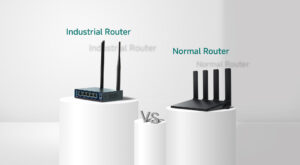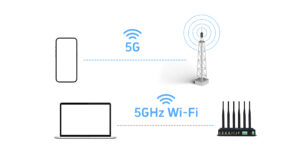In the digital age, the Internet has become an indispensable part of people’s daily life and work. At present, the mainstream network connection methods are mainly divided into wireless networks and wired networks, each of which has unique advantages and limitations. Understanding the characteristics of the two can help us choose the appropriate network connection method according to different usage scenarios and needs.
Wireless Networks: A Flexible and Convenient Connectivity Method
Wireless networks refer to network connection methods that transmit data via radio waves without the need for physical cables. Common examples include Wi-Fi, Bluetooth, 4G/5G, etc.
Ventajas
High mobility: The greatest advantage of wireless networks is that they allow users to move freely within the coverage area without being constrained by cables. Whether moving around at home or in the office or in public places such as cafes or airports, users can maintain a network connection at all times to meet their needs for internet access, work, and entertainment.
Easy deployment: Compared with wired networks, wireless networks are easier and faster to deploy and do not require a lot of wiring work. Network coverage can be achieved by simply installing wireless routers and other equipment. In industrial environments, industrial Wi-Fi routers can be quickly deployed in complex places such as production lines and storage areas due to their resistance to high and low temperatures and electromagnetic interference, without the need for large-scale reconstruction of existing industrial facilities. This has great advantages in some places where it is difficult to lay cables (such as old buildings, temporary office areas, and industrial scenes such as production workshops and outdoor base stations).
High device compatibility: Most smart devices (such as smartphones, tablets, and industrial sensors) support wireless connections. In the industrial field, sensors communicate with enrutadores industriales via Wi-Fi to transmit data in real time to the central control system. In homes, smart TVs, robot vacuum cleaners, and other devices can directly connect to ordinary Wi-Fi routers to achieve whole-house connectivity.
Disadvantages
Poor stability: Wireless network signals are easily interfered with by various factors, such as walls, furniture, and other wireless devices, leading to unstable network speeds, high latency, and even disconnections. In areas with high network usage density (such as office buildings and schools), interference between multiple wireless networks can be more severe, affecting the network experience.
Limited transmission speed: Although wireless network transmission speeds have significantly improved (e.g., 5G networks theoretically achieve speeds of up to 1 gigabit per second), in practical use, factors such as signal interference and device performance often prevent actual transmission speeds from reaching theoretical values. In contrast, wired networks offer more stable and reliable transmission speeds.
Lower security: Wireless network signals transmitted via radio waves are more susceptible to hacking and eavesdropping. While security can be enhanced through measures like setting passwords and encryption, certain security risks still exist.
Wired networks: A stable and high-speed connection option
Wired networks refer to network connection methods that transmit data through physical cables (such as Ethernet cables or fiber optics), such as Ethernet.
Ventajas
High stability: Wired networks connect devices via physical cables, unaffected by external electromagnetic interference or other wireless signals, resulting in more stable connections and lower latency. This offers significant advantages in scenarios that require high network stability, such as online gaming, video conferencing, and big data transmission. For example, when playing online games, a stable network connection ensures smooth gameplay and prevents network latency from degrading the gaming experience.
Fast transmission speed: The transmission speed of wired networks is typically much higher than that of wireless networks, especially when using fiber optic cables. This is ideal for scenarios requiring the transmission of large amounts of data, such as downloading high-definition videos or sharing files.
High security: Wired network signals are transmitted through physical cables, making them less susceptible to external interception and interference, thus offering relatively high security. Additionally, wired networks can further enhance security through measures like firewalls and access controls.
Disadvantages
Poor mobility: Wired network devices must be connected to network interfaces via cables, severely limiting device flexibility. If the network needs to be used in different locations, rewiring or moving the devices to a location with a network interface is required, which can be highly inconvenient in certain situations.
High deployment costs: Deploying a wired network requires extensive cabling work, including purchasing cables and installing network interfaces, which not only consumes a significant amount of time and effort but also increases deployment costs. For large buildings or facilities, the difficulty and cost of cabling work are even higher.
Lack of flexibility: The topology of a wired network is relatively fixed, and once the cabling is completed, it is difficult to modify or adjust. If network devices need to be added or removed, the cabling must be replanned and adjusted, which poses certain challenges for network management and maintenance.
How to choose the appropriate network connection method
Wireless networks and wired networks each have their advantages and disadvantages. In practical applications, the appropriate network connection method should be selected based on different usage scenarios and requirements.
Home and small office scenarios: In home and small office scenarios, users have high requirements for network mobility while also needing to meet daily internet access, office work, and entertainment needs. Therefore, a wireless-primary, wired-secondary approach can be adopted. For example, wireless routers can provide wireless network coverage, while devices with high requirements for network speed and stability (such as desktop computers and smart TVs) can be connected via wired networks.
Large enterprises and data centers: In large enterprises and data centers, users have high requirements for network stability, transmission speed, and security and need to connect a large number of devices. Therefore, a wired network-based approach with wireless networks as a supplement is typically chosen. By laying fiber optic cables, twisted-pair cables, and other cables, a high-speed, stable, and secure network environment is constructed, with wireless network coverage provided in areas with a high concentration of mobile devices, such as meeting rooms and break areas.
Outdoor and mobile scenarios: In outdoor and mobile scenarios (such as travel, business trips, and fieldwork), users need to maintain network connectivity at all times, making wireless networks the only viable option. Network connectivity can be achieved through 4G/5G mobile networks, mobile hotspots, and other means.
In summary, wireless networks and wired networks each have their own application value in different scenarios. As technology continues to advance, the stability and transmission speed of wireless networks will continue to improve, while the deployment costs and flexibility of wired networks will also be enhanced. In the future, the two may become more closely integrated to provide users with more convenient, efficient, and stable network services.


